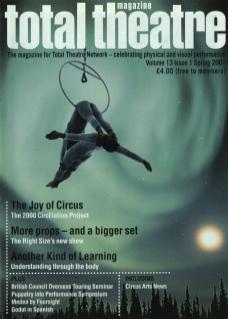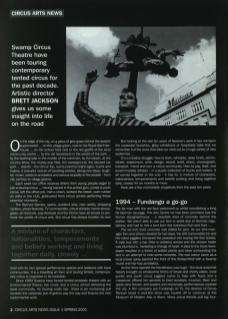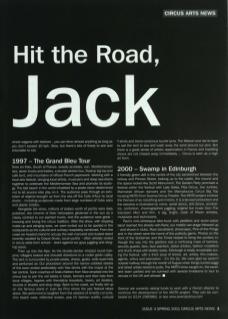On the edge of the city, on a piece of grey grass behind the derelict supermarket... on the village green, next to the Royal Oak Free-house... on the school field next to the red graffiti of the local community centre... by the old bandstand in the centre of the park... by the boating lake in the middle of the common, by the beach, at the country show, the muddy pop field, the wasteground, the disused car park... stands – the Circus Top, surrounded by bright signs, trucks and trailers. A colourful mixture of travelling artistes, taking new ideas, laughter, music, extreme acrobatics and serious stupidity to the people from city centres to village greens.
Each week our office receives letters from young people eager to join a touring circus... having trained in the school gym, joined a youth circus, left the office job, met a clown, worked the street, worn rubber on stilts in the club, graduated from circus school perfecting those essential moments...
The Olympic Games, opera, clubland acts, new variety, shopping centres, street festivals, TV commercials, circus schools, horror shows, galas, art festivals, pop festivals and the Dome have all served to promote the profile of circus arts. But circus has always trodden its own road with its own special performance spaces and relations with local communities. It is a travelling artform and touring tented, contemporary circus is important in its evolution.
Since 1992 Swamp have toured tented acrobatic theatre with an environmental theme, live music and a circus school attracting the local community. As touring costs rise there is an increasing pull towards the corporate pot of gold to pay the way and finance the new experimental work.
But looking at the last ten years of Swamp's work it has not been the corporate launches, glitzy exhibitions or hospitality balls that we remember but the tours that take our work out to a huge variety of new audiences...
It is a creative struggle: how to train, rehearse, raise funds, administrate, experiment, write, design, record, build, direct, choreograph, transport, mend and tour a circus community. How to pay, feed, and accommodate artistes – in a purple collection of trucks and trailers. It all comes together in the end – it has to; a mixture of characters, nationalities, temperaments and beliefs working and living together daily, closely for six months or more.
Here are a few memorable snapshots from the past ten years.
1994 – Fundango a go-go
The fat man with the red face welcomed us whilst brandishing a long, fat German sausage. The Arts Centre we had been promised was the former slaughterhouse – a desolate area of concrete behind the station. We aren't able to use our tent or seats due to German regulations, and had to hire a tent from the notorious Kurt and Kurt...
The six-inch thick concrete was drilled for pins. As our tent manager Tom and others vibrated for two days, the stilt-transvestite Ice and her robot jugglers menaced the populace into buying the first tickets. A cafe bus with a bar (free to artistes) arrived and the shower trailer was plumbed in, heralding a change of heart. A plea to the local newspaper resulted in a forest of potted plants and trees surrounding the tent in an attempt to hide some concrete. The real colour came as a local posse spray-painted the front of the Schlachthof with a Swamp mural and hip-hop acrobatics.
As the show opened the friendliness was huge – the local anarchist bakery brought us wholesome bricks of bread and cherry cakes, local punks and youth circus jugglers came to help with flyers, and a masseuse offered her services to tired acrobatic muscles. Beer and apple wine flowed, and posters and impromptu performances covered the city. A film company put Fundango on TV, the director of Circus Roncali loved it, and the show was hauled off to continue at the Museum of Modem Arts in Bonn. Many circus friends pull big four wheel wagons with tractors – you can drive almost anything as long as you don't exceed 10 kph. Slow, but there's lots of forest to see and chocolate to eat.
1997 – The Grand Bleu Tour
Terre en Fete, South of France, sweaty acrobats, sun, Mediterranean sea, seven trucks and trailers, a double-decker bus, Swamp big top and cafe tent, and mountains of official French paperwork. Working with a local arts festival, bringing local artists, musicians and deep-sea divers together to celebrate the Mediterranean Sea and promote its ecology. The last beach in the world inhabited by a pirate clown determined not to let anyone else play on it. The audience pass through an exhibition of objects brought up from the sea off the Cote d'Azur by local divers – including sculptures made from large numbers of Coke cans and plastic bottles.
Alongside the show, millions of dollars worth of yachts were daily polished, the chrome of their helicopters glistened in the sun as a classy contrast to our painted trucks. And the audience were great – knowing and loving the circus tradition. After the show, with dripping make-up and stinging eyes, we were invited out to be spoiled in the restaurants as the cultural and culinary hospitality combined. From the coast we headed inland to occupy the well-manured and dusted stand recently vacated by Cirque Gruss. Local youths – often already versed in circus skills from school – leant against our guys juggling and slinging yo-yos.
Then up into the Alps. As the double-decker whizzed round hairpins, villagers looked and shouted directions to a cooler green valley. The tent is surrounded by purple peaks, sheep, goats, wide-eyed kids and perfumed air. Our procession around the narrow cobbled streets of the town ended predictably with free drinks with the mayor at the bar central. Soon coaches of Arab children from Nice emptied into the circus top to join the old ladies in black, farmers and their kids from local villages, hippies with friendship bracelets, lovers, art dealers, tourists in shades and stray dogs. Back to the coast, we finally set up on the famous stand in Juan les Pins where the jazz festival takes place. We performed to laughter from the wearers of smartly cut suits, chic beach wear, reflective lenses, pop UV fashion outfits, cultural T-shirts and trend-conscious tourist lycra. The Mistral wind did its best to sail the tent to sea and wash away the sand around our pins. But there is a great sense of artistic appreciation in France and travelling shows are not chased away immediately... Circus is seen as a high artform.
2000 - Swamp in Edinburgh
A friendly green deli in the centre of the city sandwiched between the railway and Princes Street, looking up to the castle, the mound and the space-rocket-like Scott Monument. The Garden Party promised a festival within the festival with Lady Salsa, Flea Circus, Jive Junkies, Mamalodi African dancers and the Mamaloucos Circus Big Top housing MOTO from Swamp Circus Theatre. The MOTO project involves the themes of air, breathing and motors. It is a devised production and the storyline is illustrated by mime, aerial dance, stilt-dance, acrobatics, contortion, choreographed juggling, original live music from The Icecream Men and film. A big, bright clash of fifteen artistes, musicians and technicians.
Paul's rinki-dinkesque bike-truck with peddlers and seven-piece band roamed the streets with fliers; our mobile van-stage followed up – and shows in clubs, Ross bandstand, showcases, Pick-of-the-Fringe and in the street were the name of the publicity game. Photos on the front of the Scotsman and the Times helped to bring the punters in; though the way into the gardens was a confusing maze of barriers, security guards, fairs, face-painters, tattoo artistes, balloon modellers and drunk chaps with blobby noses. Edinburgh is totally remarkable during the festival, with a thick soup of shows, art, artists, film-makers, agents, critics and promoters – it's the biz. We were glad we weren't outside halfway through the month of August when things turned soggy and street artists retired to pubs. The MOTO show caught on, the excellent team partied, and we survived with several invitations to tour to venues in the UK and abroad.
Swamp are currently raising funds to work with a French director to continue the development of the MOTO project.
www.swampcircus.com


